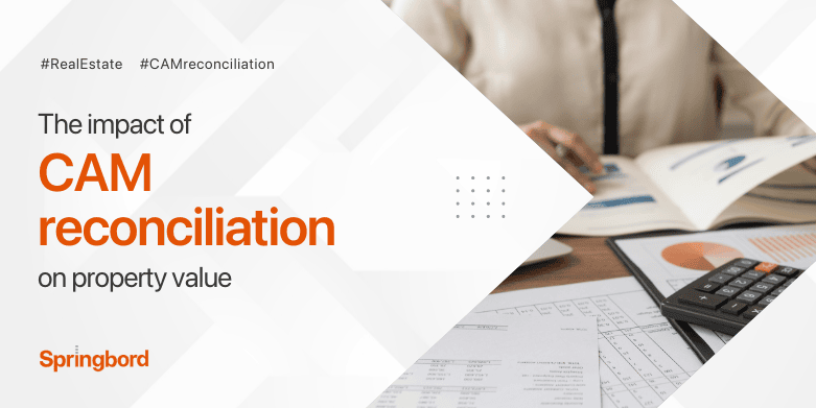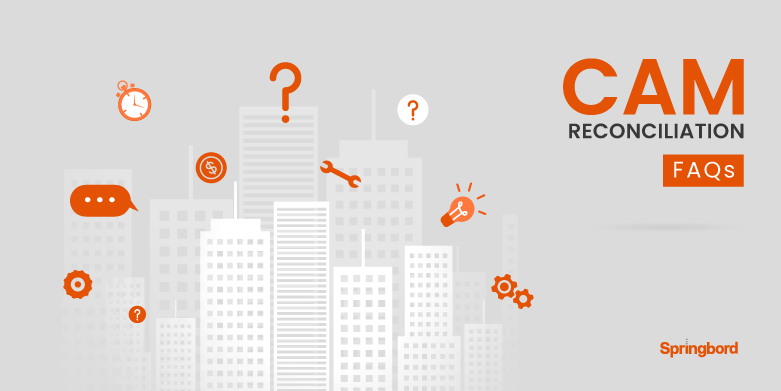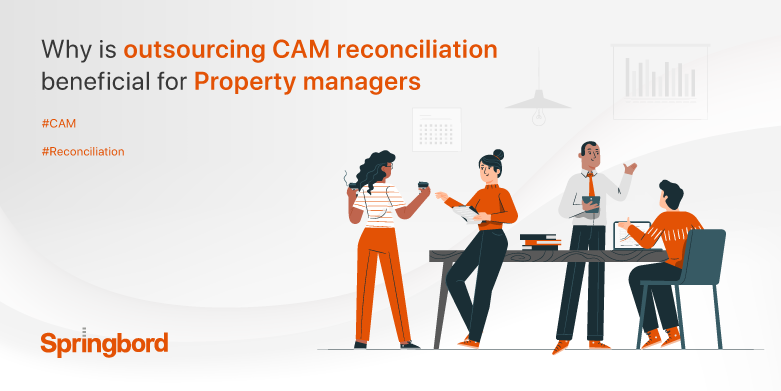 Read time 8 min
Read time 8 minThe reconciliation of CAM expenses is crucial to the financial landscape of commercial properties. The impact of CAM reconciliation on property value must be balanced. CAM reconciliation, the process of balancing common area maintenance charges, has the potential to have a significant impact on a property’s value.
Property owners, investors, and tenants must understand CAM reconciliation’s direct and indirect effects on property value.
This article will delve into the multifaceted impact of CAM reconciliation and explore its implications on property valuation.
Understanding CAM Reconciliation
A vital part of property management, CAM reconciliation compares the Common Area Maintenance fees paid by owners to the actual costs of maintaining and operating the common areas of a building or complex. Understanding the parts that makeup CAM reconciliation and its difficulties is crucial to grasp its significance fully.
Maintenance and management fees cover landscaping, utilities, cleaning, security, and repairs, among other things. Tenants typically split these costs by their lease or percentage of building ownership.
CAM reconciliation compares expenses to charges collected during the year to ensure accuracy. As a result of this procedure, landlords are more likely to get their money back for genuine costs, and tenants are more likely to pay their fair amount.
However, many circumstances can make CAM reconciliation a difficult task. Disagreements over the breadth of included expenses or the allocation mechanism might lead to questions about the charges’ correctness and transparency.
Moreover, CAM reconciliation may be further complicated by calculation or billing procedure differences. Given these obstacles, it’s clear that CAM reconciliation must be handled with extreme care if trust and equity are to be preserved.
The landlord and the renter will benefit from a thorough and honest CAM reconciliation. Property owners can rest easy knowing they can recoup their costs without going into the red and keep common spaces in good shape.
Accurate CAM reconciliation benefits tenants by giving them peace of mind that their payments are warranted and that they are not overcharged. Positive landlord-tenant relationships and a pleasant atmosphere for everyone benefit from open reconciliation practices.
Factors Influencing CAM Reconciliation
Before delving into the factors influencing CAM reconciliation, it is essential to understand what CAM charges entail. Commercial properties often assess tenants with Common Area Maintenance or CAM charges to recoup the money spent on the upkeep and operation of the building’s shared sections and common areas.
Cleaning services, gardening, security, utilities, maintenance, and management fees may add up quickly. Tenants often pay a percentage of the total CAM costs based on their part of the building’s rentable space.
A. Identification of factors affecting CAM reconciliation:
- Maintenance and repair costs: One of the biggest elements influencing CAM reconciliation is the amount spent on routine maintenance and repairs to the common spaces.
This includes cleaning and landscaping costs as well as any emergency repairs that may be necessary. CAM charges and reconciliation can be considerably impacted by the property’s condition and the quality of its infrastructure.
- Property management expenses: Property management costs are the second major factor in CAM reconciliation. All of the property manager’s time and effort is reflected in these prices.
Collecting rent, handling leases, keeping the books, getting legal advice and talking to tenants are all tasks under the property management umbrella. Property management’s efficiency and efficacy affect a property’s CAM charges and reconciliation.
- Tenant occupancy and lease terms: The number of tenants and the length of their leases significantly impact the amount of money needed for CAM reconciliation in a commercial building. The allocation of CAM costs may be affected by the number of tenants in the building and the terms of their leases.
For instance, if a property experiences a high tenant turnover rate, the surviving renters may be responsible for more CAM charges, leading to higher reconciling amounts. Lease restrictions that limit or exclude specific CAM costs can also impact the necessity of full reconciliation.
B. How these factors can impact property value:
The factors mentioned above can have a direct and indirect impact on the value of a property. Here are some ways in which these factors influence property value:
- Maintenance and repair costs: One of the most significant factors in the commercial property’s capacity to attract and retain tenants is the amount spent on maintenance and repairs to the common areas.
The value of a building can take a hit if the common areas need to be more attractive due to neglect. Conversely, a property’s value may increase if the common spaces are well cared for.
- Property management expenses: Second, the cost of property management: when done well, it may increase tenant happiness, boost occupancy, and boost a building’s bottom line.
As a result, this can raise the value of the property. On the other hand, managing the property poorly could lead to unhappy tenants, higher vacancy rates, and decreased value.
- Tenant occupancy and lease terms: Thirdly, the quality of the occupants and the lease agreement can affect the property’s worth. Tenant retention and acquisition might be difficult for properties with a high vacancy rate or contracts that allocate CAM charges unfavorably, potentially lowering the property’s value.
Positive Impact of CAM Reconciliation on Property Value
Common Area Maintenance (CAM) reconciliation is a crucial aspect of property management that involves reconciling the actual operating expenses incurred in maintaining shared areas within a property complex. CAM reconciliation is vital in enhancing property value by positively influencing various factors.
A. Increased maintenance and improved property condition:
The capacity to ensure better upkeep and improved property condition is one of the positive effects of CAM reconciliation on property value. Maintenance, repairs, and renovations to shared spaces are all covered by the CAM fees tenants pay.
Property owners can keep the common areas in good condition, cleanliness, and aesthetic appeal by allocating funds from the CAM reconciliation process to these purposes.
Regular maintenance and upgrades will improve the property’s condition and curb appeal. Tenants, tourists, and possible investors get an optimistic image from well-kept communal areas.
They show that you care about making the space comfortable for your guests and about making a good impression on them. Maintenance like this boosts the property’s quality, increasing its value and appeal to potential buyers.
B. Enhanced tenant satisfaction and retention:
Improved tenant retention and satisfaction are a direct result of accurate CAM reconciliation. Tenants enjoy living in a well-maintained and aesthetically pleasing common area. Tenants with a favorable opinion of the building and its surroundings are more satisfied with their living situation.
Tenants’ quality of life can be improved by providing extra services and amenities made possible by CAM fees. Fitness centers, meeting rooms, parking lots, security measures, and manicured grounds are all examples of amenities that may be provided. Tenant satisfaction and length of occupancy can be significantly boosted when such conveniences are made available.
Property owners can lower vacancy rates by prioritizing tenants’ happiness. Tenant vacancy, advertising, and turnover costs are all reduced when the vacancy and turnover rates are low. A property with stable revenue from pleased long-term tenants is more valuable because of the lower risk.
C. The positive perception among potential investors:
Potential investors have a favorable impression. CAM reconciliation can boost its value by improving how prospective buyers view the house. Prospective buyers evaluate commercial properties based on their financial performance and ability to profit.
Maintaining and improving a property shows fiscal responsibility and dedication to the property when the CAM reconciliation is done correctly.
Investors are likelier to put their money into a property if the CAM is appropriately reconciled. An efficient reconciliation procedure gives tenants confidence that the building is being managed properly, that CAM fee revenue is being put towards upkeep, and that common costs are being covered methodically.
A more significant number of investors may be interested in purchasing the property if they share this optimistic view, which could boost both demand and the price.
D. Higher demand and rental rates:
The positive impact of CAM reconciliation on property value is also reflected in increased demand and rental rates. Tenants are more likely to move into a building with appealing common areas and amenities if the building’s CAM expenses are well reconciled.
Tenants are more likely to be satisfied with the property if it meets their needs and preferences regarding comfort, aesthetics, and functionality. If the common areas are well cared for, the property can charge greater rents than its competitors. Rent increases result in more money from tenants, boosting the property’s value.
In addition, buildings with effective CAM reconciliation have an increased chance of succeeding in the marketplace. Tenants and businesses are interested in buildings with good common areas and amenities.
A home gains desirability and appeal when its owners show they care about keeping and improving these features. A rise in the price of these properties due to increased demand can attract more buyers.
Negative Impact of CAM Reconciliation on Property Value
If mishandled or excessive, CAM reconciliation can significantly negatively affect property value. Excessive CAM charges can burden tenants financially, leading to dissatisfaction, potential tenant turnover, and decreased attractiveness to buyers and investors.
A. Excessive CAM charges leading to the financial burden on tenants:
One of the significant drawbacks of CAM reconciliation is the imposition of excessive charges on tenants, which can put a severe financial strain on them. Tenants may need help making ends meet if CAM costs rise to an unmanageable level.
If CAM costs are too high, they may need help staying afloat financially and meeting their lease obligations. Tenants’ financial stress can have a wide range of adverse effects, including payment delays, a lack of ability to invest in or expand the business, and even bankruptcy in extreme situations.
B. Dissatisfaction and potential tenant turnover:
Tenant dissatisfaction and possible vacancy might occur from CAM charges that are too high or unexpectedly raised. If tenants aren’t given enough information or a chance to participate in the CAM reconciliation process, they may view the charges as unfair or unjustified.
Tenant and landlord relationships can suffer when tenants are unhappy, leading to a breakdown in communication, increased disagreements, and even legal action. Tenants unhappy with their living conditions may decide not to renew their leases or cancel their contracts early.
Property values decline when tenants frequently move out. A reduction in property value may result from decreased cash flow and rental income caused by vacant units. In addition, property owners may experience financial stress due to the price of advertising, tenant screening, and lease negotiations.
C. Decreased attractiveness to potential buyers and investors:
CAM reconciliation practices can significantly impact the attractiveness of a property to potential buyers and investors. There should be cause for alarm about the property’s profitability and financial stability if common area maintenance costs appear high.
Potential purchasers and investors may view the property’s income source skeptically and consider it a high-risk venture.
In addition, the mystery may put off possible investors and difficulty of CAM reconciliation. Lack of transparency or inadequate documentation during the reconciliation process might confuse and erode trust.
Investors prefer houses with clear finances and predictable costs, so a complicated or inconsistent CAM reconciliation can turn them off.
D. Lower rental rates due to higher operating costs:
A decrease in rental prices due to rising operational costs is possible because CAM fees are included in those expenditures. As a general rule, property owners will raise rents to cover any increases in CAM charges that result from a reconciliation. However, tenants may only look elsewhere for their needs if the property’s rent is reasonable.
Indirectly, rent prices may be affected by rising operating costs. With rising CAM costs, landlords may have no choice but to maintain current rental prices or lower them to keep renters. The property’s value and rental income could eventually suffer due to this.
To Sum Up
The impact of CAM reconciliation on property value must be considered. Fair and accurate CAM reconciliation practices are essential for preserving and enhancing property value.
It is essential to prioritize effective reconciliation processes as property owners and managers navigate the challenges and complexities of CAM charges. Property owners can develop trust with tenants, foster positive landlord-tenant relationships, and increase property value by ensuring accuracy, fairness, and transparency.
To facilitate this procedure, companies such as Springbord provide valuable services, such as data labeling tailored to each client’s specific requirements. Springbord can assist property owners and administrators in making informed decisions based on accurate and trustworthy data, thereby enhancing the positive effect of CAM reconciliation on property value.







